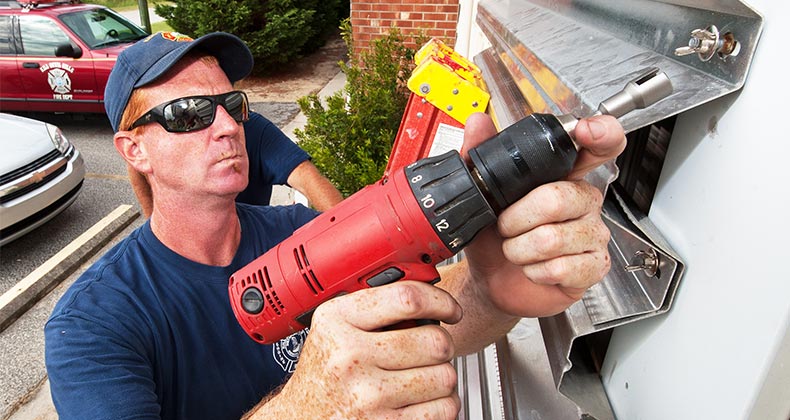How to get financial assistance after a natural disaster strikes

Key takeaways:
- Learn your financial options before a natural disaster occurs.
- An emergency savings cushion can help you weather a financial storm.
- Review your insurance policies and know what they do and don’t cover.
You never know when a winter storm will hit.
And it doesn’t matter whether you’re in Buffalo, New York or Dallas, Texas, a winter storm can be a natural disaster.
Knowing the various financial options you have available for a natural disaster is important when you have an unexpected event happen to your property, especially because 62 percent of Americans feel they’re behind when it comes to emergency savings. That’s why it’s worth considering setting money in a savings account that earns a competitive yield.
Here are some places where you may be able to obtain financial assistance or tap your funds to restore your home, business or other property after being hit by a natural disaster:
Key insights: The impact of extreme weather on your personal finances
- More than 1 in 4 (26%) U.S. homeowners say they’re unprepared for the potential costs associated with extreme weather events in their area.
- 20% of U.S. Southern homeowners say that they would be unable to pay their deductible without going into debt if their home sustained major damage from a severe weather event, the highest percentage of all other regions.
- Only 48% of U.S. homeowners earning under $50,000 per year say they’re financially prepared for the potential cost associated with extreme weather events in their area compared to 71% of homeowners earning $100,000 or more.
- Nearly one in four (27%) of Americans say they have no emergency savings.
Your insurance policy
You should talk to your insurance company as soon as possible if you own a home that was damaged due to a natural disaster, says Wendy Terrill, a retirement planning counselor at Assurance & Guarantee in Burlington, North Carolina.
The quicker you file a claim, the better. And it’s important to be proactive if you’re in a disaster-prone area. You should make sure you have the necessary coverage depending on where you live, such as flood insurance if you live along the coast.
“Always be sure to know the extent of your policies and what they do and don’t cover,” Terrill says. “Be aware, there can be time limits on how long you have to file, so it’s important to act quickly when filing a claim.”
In some cases, Terrill adds, it’s prudent to get a second opinion when totaling up the damage.
“Make sure to consult your own qualified public adjuster, not the insurance company’s adjuster, as well as an attorney,” Terrill says. “Not only can this expedite the process, it will also help protect you. Filing insurance claims can help cover costs and shore up cash savings for other things that aren’t covered by insurance.”
Review your policy to see what would happen if the pipes in your house froze or if the weight of snow causes roof damage.
Emergency savings
Setting up an emergency fund when life is good can help you when something out of your control happens, such as a natural disaster.
Because a natural disaster is regarded as an emergency, it makes sense to use your emergency fund for repairs rather than using a credit card and taking on high-interest debt. A credit card is fine as long as you can pay the balance in full within the billing cycle, but if you have to rely on it, or a loan, to cover expenses from a disaster, then you run this risk of taking on high debt and interest.
Natural disasters can occur anywhere and at any time, that’s why it’s wise to set up an emergency savings account should those unexpected acts of nature occur in your neighborhood.
The federal government
The federal government usually makes resources available to help natural disaster victims. The type of assistance that you qualify for will depend on your unique situation. Here are some of the most common assistance programs and providers:
FEMA: Federal Emergency Management Agency
FEMA offers a variety of programs to support disaster survivors. As soon as the area is safe, FEMA will arrive to start helping impacted individuals survive the fallout of a natural disaster.
In addition to many on-the-ground programs that provide food and shelter as well as cover expenses like moving, storage and clean-up, you could receive Disaster unemployment assistance. Typically, any unemployment benefits related to a disaster will be paid for up to 26 weeks.
If you want to apply for FEMA assistance or explore your options, head to the FEMA Disaster Recovery Center (DRC). These mobile offices are set up after a disaster to help the affected residents navigate the crisis. For complete information, go to FEMA’s website.
Small Business Administration Disaster Assistance
As a business owner who was affected by a declared disaster, you can access resources provided by the Small Business Administration (SBA). You will find four types of loans available after a disaster: physical damage loans; mitigation assistance; economic injury disaster loans; and military reservist loans. These loans cover things like home repairs, a business owner’s operating expenses and other financial hardships you might suffer.
You can take advantage of these loan opportunities to help you weather any financial storm if you have a small business affected by a declared disaster.
IRS: Internal Revenue Service assistance
The IRS, better known as the steward of tax collection, isn’t typically associated with offering a helping hand in the aftermath of a natural disaster. However, the IRS may be able to help alleviate some pressing bills. For example, you may receive an extension on your tax payment deadline. That could be a big help if you are running low on funds while rebuilding after a natural disaster.
DAIP: Disaster Assistance Improvement Program
DAIP is a lesser-known unit managed by FEMA that can help you get back on your feet following a disaster. The goal of DAIP is to help you find the resources you need more easily.
If you are tired of reading through an alphabet soup of agency programs to find the pertinent information, then head to DAIP’s Find Assistance page. You can enter your information on the site and receive a unique list of resources and assistance programs that could help you — and save you a lot of time.
Your life insurance policy
If you have a cash value life insurance policy, now may be the time to borrow from it. (You can’t borrow from a term life policy, as it only pays out upon death.) You could cover necessary rebuilding expenses with the cash that you withdraw from your cash value life policy. And there’s no application required to gain use of your money.
If you don’t pay back the money you took from your life insurance policy, however, it will reduce the value of your death benefit, notes Sean Fox, chief revenue officer of personal finance company Achieve. “Paying the money back is not required, but any amount not paid back will be deducted from whatever goes to beneficiaries,” Fox says. So, keep that in mind as you move forward.
CDs, savings bonds and mutual funds
Money tucked away in a certificate of deposit (CD), mutual funds or savings bonds could be used in an emergency, but withdrawing money early from some accounts, such as a CD, may result in an early withdrawal penalty.
Talk to a bank representative or a financial advisor to better understand your options if you need to pull money out of these savings vehicles.
529 college savings
If you have contributed money to a 529 college savings plan for your child, then you could tap into those savings. However, you may incur a 10 percent penalty on the earnings portion of your account for any withdrawals. With that, a 529 withdrawal should be a last resort.
In addition to the 10 percent penalty, you’ll have to pay state and federal income tax on these withdrawals.
Retirement accounts
Another place to access needed cash is in retirement accounts, such as a 401(k) plan, notes certified financial planner Kyle Eaton. “401(k) plans allow participants to take out loans,” Eaton says. The maximum amount you can borrow from your plan is 50 percent of your vested balance or $50,000, whichever is less, according to the IRS.
For instance, if your 401(k) had a (vested) balance of $60,000, the maximum loan that you could take is $30,000, Eaton says.
The major drawback of these distributions is that you will have to repay the account that you took the funds from. Additionally, it could delay your retirement by derailing your savings goals.
Non-government organizations (NGOs)
NGOs, which are often non-profit organizations, often show up to provide help when a natural disaster strikes. Many are able to provide the money and resources needed to rebuild.
Take some time to research the NGOs that are offering assistance in your area. You might be surprised to find a helping hand just around the corner. Examples of NGOs include the International Red Cross, Doctors Without Borders and REACT International.
Bottom line
A natural disaster can turn your world upside down, quite literally. However, there’s a good chance you won’t have to rebuild alone. Many organizations and individuals are available to help you get back on your feet and create a new normal.
FAQs
– Bankrate writer Sheiresa McRae Ngo contributed to updates of this story.
You may also like


6 steps to take after a natural disaster

How to prepare your home for a natural disaster

How to financially prepare and recover from a natural disaster


